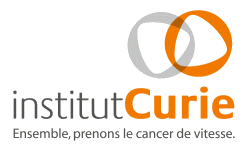
The web supplement to
Fabien Reyal et al. 2011



|
|


|
| Primary breast cancer xenografts maintain the molecular profiles of corresponding patient’s tumors and recapitulate a part of stroma microenvironment |
| Fabien Reyal1*, Charlotte Guyader2*, Charles Decraene2,3, Carlo Lucchesi4, Nathalie Auger2, Franck Assayag2, Ludmilla De Plater2, David Gentien5, Philippe Hupé3,6, Nicolas Servant6, Marie-France Poupon2, Paul Cottu2,7, Patricia De Cremoux8, Anne Vincent-Salomon8, Sergio Roman-Roman2, Olivier Delattre4, DidierDecaudin2,7# and Elisabetta Marangoni2# |
|
*the first two authors contributed equally to this work #the two authors contributed both as last authors. Authors’Affiliations: 1Department of Surgery and UMR144 Institut Curie, Molecular Oncology Team, Institut Curie, 26 rue d’Ulm, 75005 Paris, France 2Translational Research Department, Institut Curie, 26 rue d’Ulm, 75005 Paris, France 3CNRS, UMR144, Institut Curie, 26 rue d’Ulm, 75005 Paris, France 4INSERM U830, Institut Curie, 26 rue d’Ulm, 75005 Paris, France 5Affymetrix platform, Translational Research Department, Institut Curie, Paris, France 6INSERM, U900, Institut Curie, 26 rue d’Ulm, 75005 Paris, France 7Department of Medical Oncology, Institut Curie, 26 rue d’Ulm, 75005 Paris, France 8Department of Tumor Biology, Institut Curie, 26 rue d’Ulm, 75005 Paris, France |
|
Abstract Introduction: Identification of new therapeutic agents for breast cancer (BC) requires preclinical models that reproduce the molecular characteristics of their respective clinical tumors. In this work, we analyzed the genomic and expression profiles of human BC xenografts and the corresponding patient tumors. Methods: Eighteen BC xenografts were obtained by grafting tumor fragments from patients into Swiss nude mice. Molecular characterization of patient tumors and xenografts was performed by DNA copy number analysis (aCGH) and gene expression analysis using Affymetrix Microarrays. Results: Comparison analysis showed that 14/18 pairs of tumors shared more than 56% of copy number alterations (CNA). Unsupervised hierarchical clustering analysis showed that 16/18 pairs segregated together, confirming the similarity between tumor pairs. Analysis of recurrent CNA changes between patient tumors and xenografts showed losses in 176 chromosomal regions and gains in 202 chromosomal regions.Gene expression profile analysis showed that less than 5% of genes presented recurrent variations between patient tumors and their respective xenografts; these genes largely corresponded to human stromal compartment genes. Finally, analysis of different passages of the same tumor showed that sequential mouse-to-mouse tumor grafts did not affect either genomic rearrangements or gene expression profiles, suggesting genetic stability of these models over time. Conclusions: this panel of human BC xenografts maintains the overall genomic and gene expression profiles of the corresponding patient tumors and remain stable throughout sequential /in vivo/ passages. The observed genomic and gene expression differences appear to be due to loss of human stroma. These xenografts therefore represent a validated model for preclinical investigation of new therapeutic agents. Introduction: Identifying new therapeutic agents for breast cancer (BC) treatment requires preclinical models that recapitulate the molecular characteristics of their respective clinical tumors. In this work, we analyzed the genomic and expression profiles of human BC xenografts and their corresponding patient’s tumors. Methods: Eighteen BC xenografts were obtained by grafting tumor fragments from patients into swiss nude mice. The molecular characterization of patient’s and xenograft’s tumors was performed by DNA copy number analysis (aCGH) and gene expression analysis using Affymetrix Microarrays. Results: by comparing the genomic profiles of BC xenografts with those of respective patient’s tumors, we found that 14 pairs of tumors share more than 56% of copy number alterations. Unsupervised hierarchical clustering analysis showed that 16/18 pairs segregated together further indicating the striking similarity between paired tumors. At the level of gene expression profile few variations were found between patient’s tumor and their respective xenografts, i.e. 371 genes that were differentially expressed in more than 84% of paired tumors and that largely represent human stromal compartment related genes. Furthermore, analysis of gene expression by murine stroma revealed a partial but significant recapitulation of the primitive human stroma. Finally, by analysing different tumor passages of the same tumor, we found that sequential mouse to mouse tumor grafts did not affect neither genomic rearrangements nor gene expression profiles, suggesting a striking genetic stability of these models across the time. Conclusions: this panel of human BC xenografts accurately maintains the genomic and the expression profiles of their corresponding patient’s tumors and are stable across sequential in vivo passages. Consequently, these xenografts represent a validated model for preclinical investigation of new therapeutic agents. |
| Download data: | ||
| Affymetrix Raw data (cel files) and Description (xls) | Get them (.zip) |
| Last modified October 03 2011 15:55:02 |